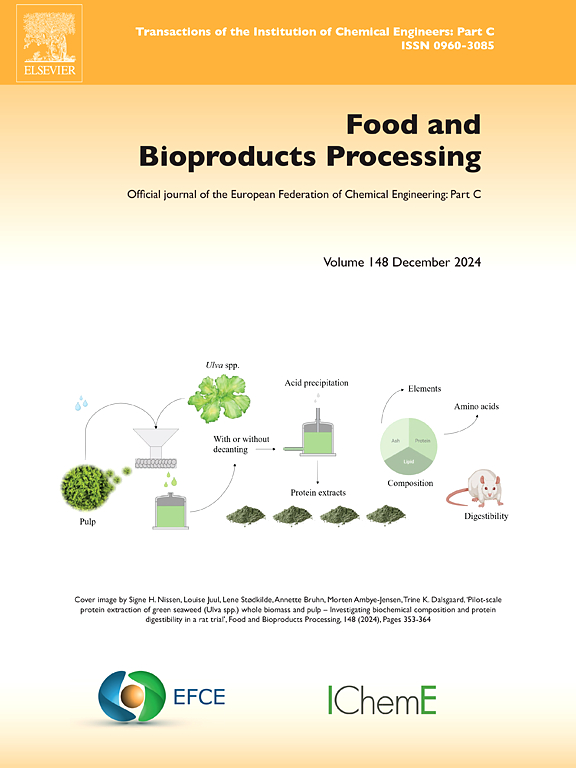中性醇蒸馏工艺的全厂优化
IF 3.4
2区 农林科学
Q2 BIOTECHNOLOGY & APPLIED MICROBIOLOGY
引用次数: 0
摘要
中性(医用)酒精是一种特殊等级的乙醇,广泛用于制药和化妆品。随着COVID-19的传播,近年来乙醇的医疗用途的重要性显着增加。因此,在本研究中,通过考虑包含19个组分的工业进料和一个实际的蒸馏装置,在第一部分中模拟了由两个蒸馏塔组成的生物乙醇酒精生产过程的蒸馏部分,目的是将污染物降低到中性酒精标准规定的水平。在详细阐述热力学建模问题并用实际数据验证模拟结果后,使用方差分析进行敏感性分析,以确定最具影响力的因素(决策变量)。总体而言,选择了10个决策变量进行优化。采用遗传算法(GA)和BOBYQA算法使中性酒精产量最大化。优化算法仅使用两个蒸馏塔即可满足伊朗中性醇标准的所有限制,乙醇的回收率为89.95 %,作为中性醇和生物乙醇产品。这一数值与传统的中性酒精生产工艺相当,证实了其作为一种可行的生产方法的应用。本文章由计算机程序翻译,如有差异,请以英文原文为准。
Plant-wide optimization of neutral alcohol distillation process
Neutral (medical) alcohol is a special grade of ethanol widely used in pharmaceuticals and cosmetics. Following the spread of COVID-19, the importance of the medical use of ethanol has increased significantly in recent years. Therefore, in this study, the distillation section of the bioethanol alcohol production process comprising two distillation columns was simulated by considering an industrial feed comprising 19 components and an actual distillation plant in the first part with the aim of reducing contaminants to the levels set by neutral alcohol standards. After elaborating on the thermodynamic modeling issues and validating the simulation results with real data, a sensitivity analysis was performed to determine the most influential factors (decision variables) using ANOVA. Overall, ten decision variables were selected for the optimization. The genetic algorithm (GA) and BOBYQA algorithm were utilized to maximize neutral alcohol production. The optimizing algorithms successfully satisfied all the limitations set by Iran’s neutral alcohol standard using only two distillation columns, whereas the ethanol recovery was 89.95 % as neutral alcohol and bioethanol products. This value is comparable to that of conventional neutral alcohol production processes, and confirms its application as a viable production method.
求助全文
通过发布文献求助,成功后即可免费获取论文全文。
去求助
来源期刊

Food and Bioproducts Processing
工程技术-工程:化工
CiteScore
9.70
自引率
4.30%
发文量
115
审稿时长
24 days
期刊介绍:
Official Journal of the European Federation of Chemical Engineering:
Part C
FBP aims to be the principal international journal for publication of high quality, original papers in the branches of engineering and science dedicated to the safe processing of biological products. It is the only journal to exploit the synergy between biotechnology, bioprocessing and food engineering.
Papers showing how research results can be used in engineering design, and accounts of experimental or theoretical research work bringing new perspectives to established principles, highlighting unsolved problems or indicating directions for future research, are particularly welcome. Contributions that deal with new developments in equipment or processes and that can be given quantitative expression are encouraged. The journal is especially interested in papers that extend the boundaries of food and bioproducts processing.
The journal has a strong emphasis on the interface between engineering and food or bioproducts. Papers that are not likely to be published are those:
• Primarily concerned with food formulation
• That use experimental design techniques to obtain response surfaces but gain little insight from them
• That are empirical and ignore established mechanistic models, e.g., empirical drying curves
• That are primarily concerned about sensory evaluation and colour
• Concern the extraction, encapsulation and/or antioxidant activity of a specific biological material without providing insight that could be applied to a similar but different material,
• Containing only chemical analyses of biological materials.
 求助内容:
求助内容: 应助结果提醒方式:
应助结果提醒方式:


